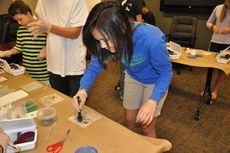
Courtesy Greer Police Department
Dakota Fitzgerald gets fingerprinted by Tyler Pearson at the Greer Police Department's CSI: Camp today. Dakota can verify that television's portrayal of collecting prints and analyzing them is somewhat exaggerated.

Courtesy Greer Police Department
Christian Alexander dusts for fingerprints at today's class at the Greer Police Department. Each student received its own fingerprint kit and learned the meticulous science of collecting prints. Christian attends Blue Ridge Christian Academy.
Fingerprints are intricate and unique from person to person, containing endless information. Today’s session allotted time to learn the art of collecting fingerprints with the use of our new fingerprinting kits.
Though all of this and the learning process was wonderful, one aspect in particular stood out to me. Angie Childers made a comment pertaining to TV and the way in which it depicts the analysis of fingerprints, stating playfully that she wishes it were that easy.
It is not as simple as scanning a print into a database and running it for possible matches. While there are some programs that assist in narrowing the possibilities, a print analyzer must put in hours to match an unknown print to a possible suspect’s print.
Police must examine prints under a microscope and compare the different characteristics such as the way ridges diverge as well as where appendages occur. Police are also able to locate the delta, a spot in the print in which the basic pattern starts or stop. These different characteristics are key to identifying a match in prints, yet are so miniscule an untrained eye would unlikely notice them.
I can only imagine the pressure a latent print analyzer must feel when the verdict of a case is resting on their shoulders. This makes the verification process critical.
A single print lifted from the sticky side of tape can make or break a case; however, prints left behind at a crime scene are hardly ever “pretty”. Most prints collected are partials or distorted due to the surface adding yet another ounce of difficulty to this job resulting in even more pressure; pressure that only a well equipped and determined latent analyzer can overcome . . . not a database.